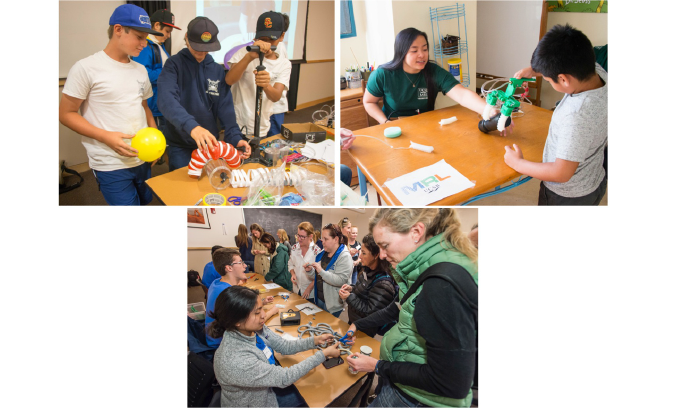Program Highlights for year 2018
In response to the needs of teachers, the UCSB MRSEC has placed a new focus on the development of maker activities for K-12 students. These encourage the integration of maker activities into the school curriculum as well as within out-of-school environments (Maker Faires), supporting the adoption of Next Generation Science Standards (NGSS).
Atomically-precise fabrication methods are critical for the development of next-generation technologies which rely on nanomaterials. New methods are particularly needed in van der Waals (vdW) heterostructures where it is necessary to individually address each molecular layer to form devices with nanometer thicknesses. The Illinois MRSEC has demonstrated a highly selective etching technique using graphene as a monolayer etch stop within vdW heterostructures. This technique is a versatile and simple nanofabrication process that bridges the challenging technological divide between atomic-precision and wafer scale uniformity.
Information stored in magnetic materials is often read-out by measuring changes in magnetoresistance. Large magnetoresistance effects are thus important for establishing well-defined memory states within materials that store information. The Illinois MRSEC discovered a new and large magnetoresistance effect generated when a topological insulator (TI) is placed on top of an ordinary magnetic insulator. The surface of the TI becomes magnetic and exhibits a so-called surface-state anisotropic magnetoresistance. This effect is two-orders of magnitude larger than previous effects induced in similar materials.
Ferromagnetism in monolayer van der Waals materials (vdW) has recently drawn tremendous attention since they were first discovered last year. Most of the materials found, however, are semiconductors and extremely air sensitive, so a vdW material that is metallic and stable under ambient conditions is highly desirable.
The presence of isolated defects in the lattice of large band-gap semiconductors can introduce colored centers, by altering their electronic properties giving rise to transitions within the visible region. Diamond has a rigid and dense lattice preventing defect diffusion and phase transitions under high pressure and temperature settings.
The CDCM Arts+Sciences Collaboratory Residence Program is educating MRSEC students, post-docs and faculty about the ways in which contemporary artists are using and developing advanced technologies.
Researchers at the University of Texas - Austin find that manipulating biological electron transport pathways may be a general strategy for allowing bacteria to produce or communicate with synthetic materials.
Researchers at the University of Texas - Austin have discovered a new method to separate valley index using a designed metasurface. Excitons that carry different valley index are routed toward different directions in real space and momentum space, and photons emitted go to different directions according to their helicity.
Experimental evidence in MBE-grown FeGe thin films for “chiral bobbers”, topological spin texture that exist near an interface.
Theoretical modeling predicts stable chiral bobbers in materials with both bulk and interfacial DMI.
Lorentz TEM imaging of skyrmions in FeGe thinned crystals
The CEM Internal Advisory Council, a grassroots committee of students and postdoctoral researchers, created POEM to inform the Center’s direction and improve the educational and research experiences of CEM students.
Pages









